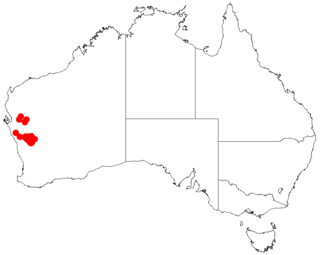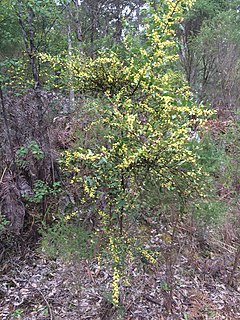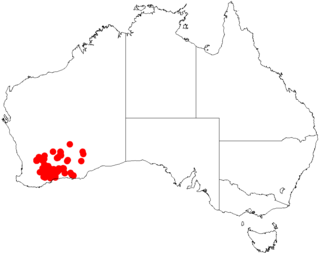
Acacia incognita, also known as false sugar brother, is a shrub or tree belonging to the genus Acacia and the subgenus Juliflorae that is endemic to Western Australia.
Acacia claviseta, also known as the club-tipped whorled wattle, is a shrub belonging to the genus Acacia and the subgenus Lycopodiifoliae that is endemic to north western Australia.

Acacia horridula is a shrub belonging to the genus Acacia and the subgenus Phyllodineae that is endemic to south western Australia.
Acacia leptalea, commonly known as Chinocup wattle, is a shrub belonging to the genus Acacia and the subgenus Phyllodineae that is endemic to a small area in south western Australia. It is listed as threatened according to the Environment Protection and Biodiversity Conservation Act 1999.

Acacia saxatilis is a shrub of the genus Acacia and the subgenus Phyllodineae that is endemic to south western Australia

Acacia shuttleworthii is a shrub of the genus Acacia and the subgenus Phyllodineae that is endemic to western Australia.

Acacia urophylla, commonly known as pointed leaved acacia, tall-leaved acacia, veined wattle or net-leaved wattle, is a shrub of the genus Acacia and the subgenus Phyllodineae endemic to Western Australia.

Acacia ancistrophylla is a shrub of the genus Acacia and the subgenus Plurinerves that is native to several areas on southern Australia.

Acacia aulacophylla is a shrub of the genus Acacia and the subgenus Plurinerves that is endemic to western Australia.

Acacia bartlei, commonly known as Bartle's wattle, is a shrub or tree of the genus Acacia and the subgenus Plurinerves. It is native to a small area along the south coast in the Goldfields-Esperance region of Western Australia.

Acacia benthamii is a shrub of the genus Acacia and the subgenus Plurinerves. It is native to an area along the west coast in the Perth metropolitan region and Wheatbelt region of Western Australia.

Acacia campylophylla is a shrub of the genus Acacia and the subgenus Plurinerves that is endemic to a part of south western Australia.

Acacia cassicula is a shrub of the genus Acacia and the subgenus Plurinerves that is endemic to an area of south western Australia.

Acacia consobrina is a shrub of the genus Acacia and the subgenus Plurinerves that is endemic to south western Australia.

Acacia deltoidea is a shrub of the genus Acacia and the subgenus Plurinerves that is endemic to north western Australia.

Acacia flavipila is a shrub of the genus Acacia and the subgenus Plurinerves that is endemic to an area of south western Australia.

Acacia heteroclita is a shrub or tree of the genus Acacia and the subgenus Plurinerves that is endemic to south western Australia.

Acacia loxophylla is a shrub of the genus Acacia and the subgenus Plurinerves that is endemic to an area of south western Australia.

Acacia triptycha is a shrub or tree of the genus Acacia and the subgenus Plurinerves that is endemic to an area of south western Australia.

Acacia uncinella is a shrub of the genus Acacia and the subgenus Plurinerves that is endemic to an area of south western Australia.

















